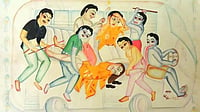Gruesome crimes like the Aaftab Poonawala-Shraddha Walkar case send shock waves, remain embedded in public memory, and even inspire slick psycho thrillers. After every such crime, the public obsesses over the dark, twisted mind, and the fate of their victims. Attempts are made to pinpoint possible psychopathological predispositions and character traits/flaws of the perpetrator, and what the victim could have done better, especially if it's a woman killed from abuse or rape.
Trauma bonding
To make sense of this situation, an understanding of diverse personality types is imperative.
Personalities capable of committing heinous crimes, notes criminal psychologist Anuja Trehan Kapur, are 50 per cent genetic, 25 per cent dependent on the development of the prefrontal cortex, and 25 per cent on the person’s social background that includes childhood traumas, socio-economic conditions, etc.
Criminal psychologist, Kapur adds, studies five personality types: Narcissists, Emotionally Unstable, Paranoid, Sadist, and Predatory. “Extremities in toxic personality traits are also the reason that certain individuals indulge in acts like stalking, voyeurism, and the like,” she says. Against this backdrop, when two co-dependent personality types form an attachment, the resultant relationship is vulnerable to violence.
Aaftab, Kapur says, is a classic narcissistic and sadistic personality type, excessively preoccupied with the ‘self’ and only looking for things that can benefit them. There’s also uncontrolled and extreme rage.
“This kind of personality emerges as an evil person, a psychopath. People like him are born with criminal traits. He will love this limelight. This murder, for him, is like getting a trophy.” Shraddha, she says, comes across as an emotionally unstable and paranoid personality, who fed off Aaftab’s narcissism, which caused trauma bonding “She found it difficult to detach from him, despite the destructive nature of their relationship. She was distanced from friends and family but stayed on because Aaftab was using her as a host, and she had turned dependent on him. Eventually, he turned sadistic and predatory, due to piled-up grudges either due to their regular quarrels or her possible pregnancy, and wanted to be free of her.”
Going by the comments under online news reports of the case or left on Shraddha’s social media profiles, the public is unable to wrap its head around why an educated, modern-age woman like Shraddha continued to stay on. Mehreen Muneer, a Srinagar-based clinical psychology research scholar, directs our attention back to Aaftab, saying he could have an antisocial personality disorder (ASPD). Basically, people who defy laws, are apathetic, and indifferent about their actions, may have experienced child abuse and become desensitised early on.
“ASPDs first take you on Cloud 9. Once they satisfy that urge to conquer you, they start showing their true colours. Maybe Aaftab made Shraddha feel there was no way out. She was isolated from family and friends, she had no support and maybe was made to feel being with him was the best she could get. Aaftab did not become this person in a day. Perhaps, Shraddha was just one of his victims who unfortunately met this fate. ASPDs try and test their methods, learn from their mistakes, are good at gaslighting, and make the victim feel ‘It’s you not me, you deserved it’. American serial killer Ted Bundy, in his films, said women are like ‘potted plants'. Likewise, Aaftab didn’t feel he did anything wrong by putting her in a fridge and bringing other women to his flat. She was just an object that he wanted to get rid of.”
Muneer is appalled by the social media comments that were victim shaming, blaming Shraddha for going against her parents, and going for a live-in relationship. “Of course, the communal colour was thrown in, but even after a heart-wrenching murder, the woman is blamed. Some of the people behind the screens could also be ASPDs.”
Telltale signs
Be it one instance or constant exposure, any kind of witness to extreme violence, is an overwhelming experience, especially if witnessed as a child. “The person gets locked in that emotional experience, and never fully gets out of it. To survive that, they will numb their emotions. Once the emotions numb out, they stay numb. The person then won’t be able to empathise, will have conversations that they cannot feel, though they will appear like normal people on the outside,” explains clinical psychologist and trauma specialist Aanchal Narang.
These children will have conduct issues, won’t follow rules, beat up kids, and even indulge in brutal acts like chopping off body parts of an animal or running it over with their bikes, points out Muneer. “The desensitisation happens early on. They learn what to do next time so they don’t get caught.”
This façade of appearing ‘normal’ will crumble if the person undergoes counselling, says Narang, as a professional counsellor can tell there’s numbing. “With the numbing, there is intense anger, and in that state, thoughts of violence give them calm. Only when there’s some thrill, like even adventure sports or drinking and driving, can the ‘super numb’ feel any emotion. If we take that thrill one step further, murder can become that thrill, when they need such an extreme emotion to be able to feel again. People who have committed multiple murders say that they only feel when they kill, and after that rush cools down, they have to kill again,” says Narang.
The general perception is that only a few out of India’s teeming millions are capable of taking a crime to such abnormal heights. Fingers point at addictive personalities like substance abusers, alcoholics, sex addicts, etc. Nothing could be further from the truth. Anything can be a trigger to stir up demons hidden in even the extremely calm and composed. Religion, for example, in India triggered common people to create genocides like the Partition, Godhra riots, Bombay riots, Delhi riots, where crowds of them torched or hacked people, raped women, pulled out their unborn foetus, eliminated entire families, basically committed violence against the very people they had lived next to in harmony for years.
Muneer says that the speck of dehumanising in riots on the basis of othering due to religion is already present in the individual. “When larger masses are mobilised, if speck is already there, it blows into a fire. Then they see others around them thinking like them, and don’t bother to rationalise. That gives confidence. Even look at WWII, the Nazis are normal people, but possess that speck, which feels that the Jews deserved it, and there’s nothing wrong if we do these things (atrocities) to them.”
Narang highlights the theory of ‘internal family systems’, how people are made up of contradictory parts. “For example, a person who sets someone aflame in a riot could otherwise be a loving father and husband and feeds random dogs on the street. This theory says most people have different parts/sides to them, which together don’t make sense, and that some parts are capable of doing horrible things if triggered enough.”
It is why calling these violent crimes ‘psychotic’, says Narang, is not the right word, “because psychosis means ‘a break from reality’, but these people live very much in the present, and their crimes, like in the Shraddha Walkar case, are pre-planned, with much contemplation about how to chop the body, distribute the parts…all indicators of psychopathy.”
Need of the hour: Qualitative Research
Can these complex pathological traits be identified and followed up with reformative action? The answer is yes.
“Scientific brain mapping and connecting the dots that ascertain one’s personality type can help,” says Kapur, pressing for urgency to conduct more qualitative research in the field. “Criminologists must be made a part of the Rajya Sabha and involved in law-making processes to study crime from the lens of victimology. The approach of reformation, restoration, and rehabilitation needs to move away from equating crime with the criminal. We are so busy hating the criminal. Who then will think of the victim’s rights? We need to empower the victim so that the offender becomes afraid of even thinking of such grievous plots.”
Kapur highlighted that “criminals like Aaftab are a rarest of rare cases, and must be studied as researchers’ ‘guinea pigs’ to understand what causes these crimes.” Citing media reports, she says that Aaftab’s comments to the police revealed that he had no remorse for what he did, and in fact, appeared confident. “A careful scrutiny of his case can help reveal how such crimes can be dealt with in future.”
External Factors
The murder plots in the American crime drama series Dexter are said to have inspired Aaftab, which begs the question of whether media exposure to violence can trigger aggressive behaviour in individuals.
The American Psychological Association (APA) in 2003 published a study that conclusively suggested that early exposure to media violence is a contributing factor to the development of aggressive tendencies. A total of 330 participants between ages 20 to 25 were studied using social-cognitive observational-learning theory, desensitisation theory, and social comparison theory to examine the relationship between early exposure to TV violence and adult aggressive behaviour.
The APA study made some startling revelations, stating, “While aggressive children may choose to watch more violent TV programmes, it is more plausible that early childhood exposure to TV violence stimulates increased aggression later in adulthood.”
But Kapur doesn’t think on-screen violence can influence someone to commit horrific crimes. Not everyone who consumes such content, she points out, ends up murdering people. “Triggers from cinematic experiences of violent crimes happen when someone is genetically and mentally predisposed to do such things. Childhood trauma, poor socialisation, violence in their families…inculcate a faulty belief system that seeks to justify horrid thoughts through exposure to such visual content,” says Kapur.
The gender angle
The APA study found men more likely to engage in violent crimes, ranging from verbal and physical aggression, especially directed at spouses, whereas women were more likely to engage in forms of indirect aggression. Even among serial killers, Kapur says, it is found that the female killers tend to use more subtle tactics like poisoning, instead of brutal violence.
Indian society still discourages men from freely expressing their emotions. These emotions get suppressed and burst out as “anger, toxic masculinity that is about control, which also seems to tip over in the nature of crimes,” says Narang. “We constantly hear about this anger or entitlement among men in North India. To commit such a violent crime, one essentially looked at the other person as not a person, basically dehumanised them.”
Any scope for change?
Narang believes these psychopathic tendencies can be rectified, and to enable that, the person must be shown how the consequences of their actions can affect people’s lives.
“If an older child loves beating up the younger sibling, tell them how the sibling is now actually scared of them, and why would you want someone to feel like that about you. But with Indian parenting, mostly the child is just slapped or yelled at,” she says. Due to the current ‘woke’ generation that approaches parenting more emotionally, it realises you cannot beat children. It recognises the importance of mental health and that every child is different and there’s hope that the impact of ‘intergenerational trauma’ can lessen with each generation and the likelihood of such crimes going down is actually a possibility.
Muneer, however, offers a blunt ‘no’. “It’s very utopian to think you can change narcissists, ASPDs. I feel you cannot change a personality because that person has been this way all their life. Faulty behaviours, traits, relationship issues, and impulsivity, can be rectified. But you cannot transform the person and make them feel empathy or remorse.”
The best form of intervention in these cases, she says, is to identify such people and separate them from society. “If done early on, full-blown acts of violence can be avoided with regular therapy and institutional help to regulate their emotions.”

























